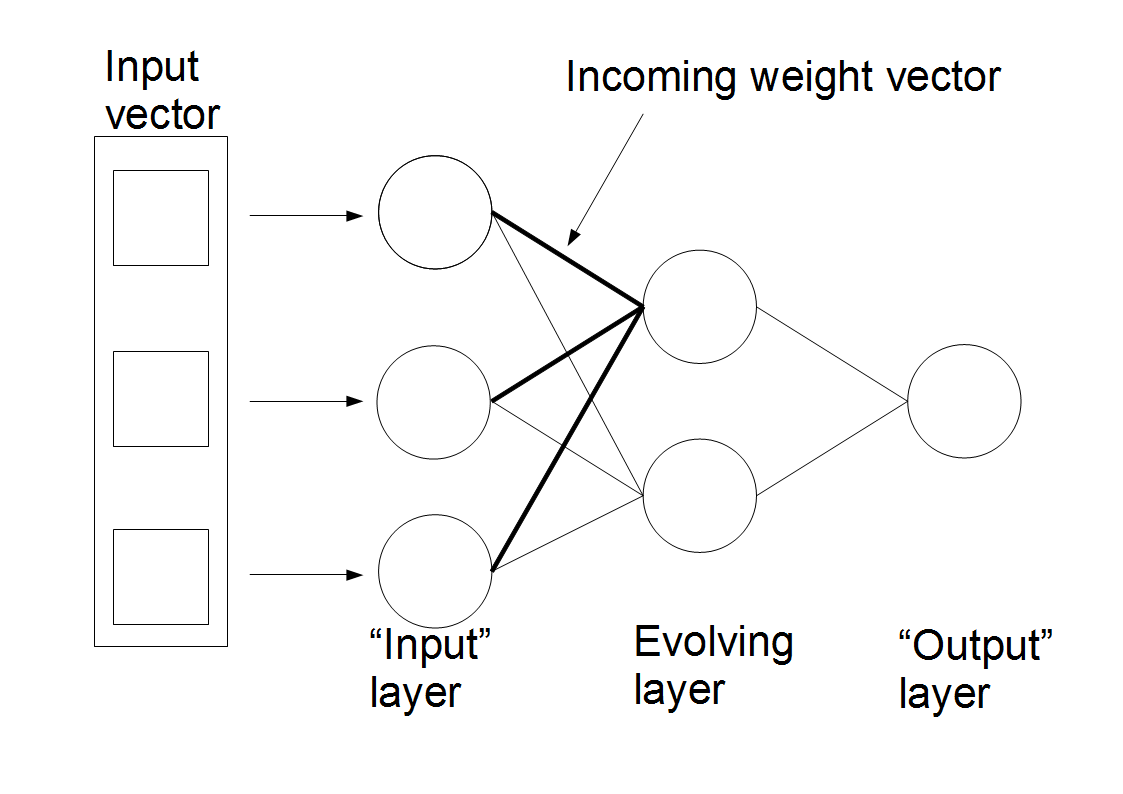 |
 |
 |
 |
 |
 |
 |
 |
 |
 |
 |
This page will introduce the basic structure of ECoS networks and the ECoS learning algorithm. At the moment, only algorithms that are included in the ECoS Toolbox are described here. More algorithms will be added presently.
An ECoS network is a multiple neuron layer, constructive artificial neural
network. An ECoS network will always have at least one "evolving" neuron layer.
This is the constructive layer, the layer that will grow and adapt itself to
the incoming data, and is the layer with which the learning algorithm is most
concerned. The meaning of the connections leading into this layer, the
activation of this layer's neurons and the forward propagation algorithms of
the evolving layer all differ from those of classical connectionist systems
such as MLP. For the purposes of this paper, the term "input layer" refers to
the neuron layer immediately preceding the evolving layer, while the term
"output layer" means the neuron layer immediately following the evolving layer.
This is irrespective of whether or not these layers are the actual input or
output layers of the network proper. A generic ECoS structure is shown
below:

is the distance between the input vector and the incoming weight vector
for that neuron.
Since ECoS networks are fully connected, it is possible to measure the distance
between the current input vector and the incoming weight vector of each
evolving-layer neuron. Although the distance can be measured in any way that is
appropriate for the inputs, this distance function must return a value in the
range of zero to unity. For this reason, most ECoS algorithms assume that the
input data will be normalised, as it is far easier to formulate a distance
function that produces output in the desired range if it is normalised to the
range zero to unity.
Whereas most ANN propagate the activation of each neuron from one layer to the
next, ECoS evolving layers propagate their activation by one of two alternative
strategies. The first of these strategies, entitled OneOfN propagation, involves only
propagating the activation of the most highly activated ("winning") neuron. The
second strategy, ManyOfN propagates
the activation values of those neurons with an activation value greater than
the activation threshold .
The ECoS learning algorithm is based on accommodating new training examples within the evolving layer, by either modifying the weight values of the connections attached to the evolving layer neurons, or by adding a new neuron to that layer. The algorithm employed is:
Propagate through the network
Find the most activated evolving layer neuron and its activation
if then
Add a neuron
else
Update the connections to the winning evolving layer neuron
end if
end if
The addition of neurons to the evolving layer is driven by the novelty of
the current training example: if the current example is particularly novel (it
is not adequately represented by the existing neurons) then a new neuron will
be added. Four parameters are involved in this algorithm: the sensitivity
threshold , the error threshold , and the two learning rates
and . The sensitivity threshold and error threshold both control the
addition of neurons and when a neuron is added, its incoming connection weight
vector is set to the input vector is, and its outgoing weight vector is set
to the desired output vector . The sensitivity and error thresholds are measures of the novelty of
the current example. If the current example causes a low activation (that is,
it is novel with respect to the existing neurons) then the sensitivity
threshold will cause a neuron to be added that represents that example. If the
example does not trigger the addition of a neuron via the sensitivity
threshold, but the output generated by that example results in an output error
that is greater than the error threshold (that is, it had a novel output), then
a neuron will be added. The incoming weight vector of a new neuron is set to
the current input vector. The outgoing weight vector of a new neuron is set to
the current output vector.
The weights of the connections from each
input to the winning neuron are modified according to the following equation:
Where:
is the connection weight from
input to at time
is the th component of the input
vector
The weights from neuron to output are modified according to the following equation:
Where:
is the connection weight
from to outputat time
is the activation of
is the error at , as measured according to the following equation:
is the desired activation value of output
is the actual activation of